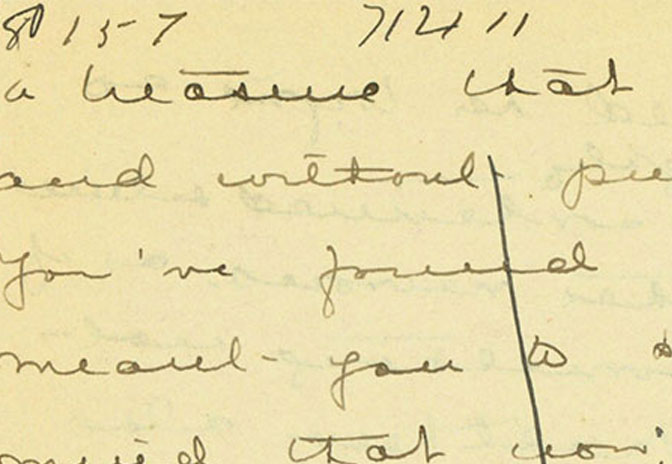Montgomery’s Imagining and Mapping
Montgomery’s Imagining and Mapping
Elizabeth R. Epperly
Montgomery did what she called “spade work” for months, outlining and making notes. She “brooded up” her central character, inventing events, dialogue, and details about setting, all to feature character. In the 1920s, when answering questions along with more than a hundred contemporary authors, Montgomery said
“I map everything out in advance. . . . Characters, plot and incidents are never changed.” 1
Montgomery explained, “In my own writing character is by far the most interesting thing to me – then setting. In the development of the one and the arrangement of the other I find my greatest pleasure . . . .” Character guided the novels; with short stories, the reverse was true. An incident would generate the character and setting needed to dramatize the central event. Anne of Green Gables established her pattern: all of her novels are character driven.
Notebooks and Outlines
Early in her writing career, Montgomery developed what she called her “note-book habit.” She filled and kept these notebooks (though none have survived), consulting them for inspiration and details. Anne of Green Gables was inspired by a decade-old entry in her notebook, made when Pierce and Rachael Macneill of Cavendish adopted a little girl: “Elderly couple apply to orphan asylum for a boy. By mistake a girl is sent them.” In real life, the orphanage sent the requested boy, but they also unexpectedly sent along his younger sister.
In her outlines, Montgomery divided a story into sections, some of which became chapters, and jotted down exactly what was going to happen, including some dialogue and descriptions. Only when the whole story was fully planned did she enjoy the real pleasure of the process, writing freely but also guided by her outline.

The first page of Montgomery’s “Synopsis” of Rainbow Valley shows the author planning the setting and opening scenes of the novel, and the typed page shows how Montgomery planned lines of dialogue, as well as the larger context of the story.
The “blocking out” and “brooding up” outlines for Anne of Green Gables no longer exist, but Montgomery preserved some story-outline pages in the manuscript of Rainbow Valley (1919), which she paid someone else to type, and Mistress Pat (1935). With Rainbow Valley, Montgomery, a busy mother and minister’s wife in Ontario, had someone type up portions of her handwritten outline and notes, and then used the handwritten and typed outline pages themselves as scrap paper for composing sections of the novel.
Inspired by Nature
Like one of her favourite novelists, Anthony Trollope, Montgomery walked to help her plan and compose. She rehearsed and puzzled out many parts of Anne’s story while she walked through what, in 1914, she called “my favorite object in Nature”: Lover’s Lane in Cavendish. Montgomery even introduced Lover’s Lane into Anne’s story, making it one of Anne’s favourite places, too. She photographed the lane for years, acknowledging it as a vital place for her imagining.

Montgomery’s photograph of Lover’s Lane, Cavendish, Prince Edward Island. Hand-tinted in the 1920s.
The green arches, alluring bends, and framed vistas of Lover’s Lane inspired the “bend in the road” image at the end of Anne of Green Gables, a metaphorical image that featured in many of her works.2
Reading and Planning
An avid reader from such a young age that she could not even recall when she began to read, Montgomery devoured books and articles, poetry, and novels all her life. In Cavendish, she read an astonishing number of magazines to keep abreast of the writing markets.3 She clipped images and pieces from magazines and colourful catalogues for her memorabilia scrapbooks.4
While planning and writing Anne’s story, Montgomery consulted her scrapbooks, finding there many of the flowers, kinds of verses, and fashion plates—especially puffed sleeves!—Anne admired. She reminisced about her findings in a long journal entry on July 30, 1905, as she would do again years later on November 22, 1926.

Page 70 of Montgomery’s “Blue Scrapbook” includes a large cutout of a woman with puffed sleeves (see Imagining Anne p. 86) .
Anne Shirley is also a voracious reader, and Anne of Green Gables is filled with allusions to popular and literary works.5 Montgomery’s well-stocked mind was also in sync with the rhythms of all she read.

1The L.M. Montgomery Reader, Volume 1: A Life in Print, edited by Benjamin Lefebvre, U of Toronto P, 2013, p. 190. Montgomery’s comments appear in From Fiction Writers on Fiction Writing: Advice, Opinions, and a Statement of Their Own Working Methods by More Than One Hundred Authors, edit by Arthur Sullivant Hoffman, Bobbs-Merrill Company, 1923; Benjamin Lefebvre reproduced select pages from Hoffman’s book in The L.M. Montgomery Reader, pp. 189-96. Back
2For an extensive discussion of the importance of Lover’s Lane to Montgomery, see Elizabeth R. Epperly, Through Lover’s Lane: L.M. Montgomery’s Photography and Visual Imagination. University of Toronto Press, 2007. Back
3 Gammel, Irene. Looking for Anne: How Lucy Maud Montgomery Dreamed Up a Literary Classic. Key Porter Books, 2008. Back
4See a large selection of these scrapbook pages in Imagining Anne: The Island Scrapbook of L.M. Montgomery, edited by Elizabeth R. Epperly, 2008, Nimbus Publishing, 2019. The original publication inspired Christy Woster, and later Carolyn Collins—continuing the late Christy Woster’s work—to try to locate all the periodicals from which the pieces were clipped. The Woster-Collins collection of original magazines and catalogues was donated to the L.M. Montgomery Institute in 2019. See also Carolyn Strom Collins, “Cutting and Pasting: What L.M. Montgomery’s Island Scrapbooks Reveal about her Reading.” Journal of L.M. Montgomery Studies, 2021. Back
5Emily Woster is at work on a database of Montgomery's reading and allusions. Her past work on Montgomery’s reading includes: “Old Years and Old Books: Montgomery’s Ontario Reading and Self-Fashioning,” In L.M. Montgomery’s Rainbow Valleys: The Ontario Years, 1911-1942, edited by Rita Bode and Lesley D. Clement, 2015, pp. 151-65; “L.M. Montgomery and Reading in/as Autobiography.” in a/b: Auto/biography Studies, vol. 29, no. 2, 2014, pp. 199–210; and “The Readings of a Writer: The Literary Landscape Created by L.M. Montgomery’s Love of Literature.” CREArTA, vol. 5, 2005, pp. 209–222. See also Rea Wilmshurst, "L.M. Montgomery's Use of Quotations and Allusions in the 'Anne' Books." CCL: Canadian Children's Literature/Litterature canadienne pour la Jeunesse, vol. 56, 1989, pp. 15-45. Rea Wilmshurst’s pioneering work enriched later annotated editions of Anne by Barry, Doody, and Doody Jones; Rubio and Waterston; and Devereaux, among others. See the Resources page for more. Back



